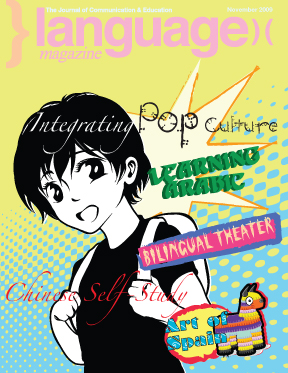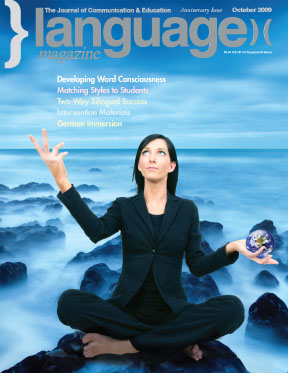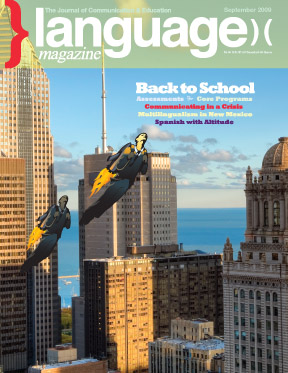 Language Magazine’s selection of products
Language Magazine’s selection of products
that incorporate technology into the ESL classroom
Alloy Multimedia
ESL ReadingSmart is a web-based English language learning environment
founded on a unique instructional design. It is easily implemented
as a student-centered, stand-alone application or a blended learning
environment, integrating online student work and classroom instruction.
The program offers individualized, content-based instruction to
develop English language proficiency with emphasis on literacy and
cross-curricular vocabulary development for newcomers, beginners,
intermediate, early advanced, and advanced English learners.
It monitors student progress, and tracks students’ readability and
grade gains based on The Lexile Framework for Reading, providing
daily, weekly, and on-demand student reports. Tracking is at individual,
class, school and district level.
Several independent studies have shown that ESL ReadingSmart is
an effective intervention program that raises students’ reading and language
scores. This year’s independent study was presented in the
National Forum of Teacher Education Journal in April. The authors stated,
“by working with culturally appropriate text at their functional reading
level, students were able to demonstrate gains while experiencing
literature that may not otherwise have been available to them.”
The program’s user friendly interface is backed by a team of professionals
always available to answer questions and provide support.
New content is regularly added so students and teachers are never
saddled with static software.
Califone
Podcasts provide new ways for students to interact with the content
matter as well as to demonstrate their learning. By creating podcasts,
students can display and extend their creativity using audio as a
means of self-expression. In addition, teachers can use podcasts to
communicate regularly with parents by posting school updates on their
web site. They can also publish lesson guides in a podcast format to
help students who many have missed sections, or who simply need
reinforcement when completing homework assignments.
MP3 players are especially useful in language learning and ELL
classrooms, where students may need additional reinforcement or
teacher guidance outside the classroom. Recording a podcast in a
language learning environment can illustrate to the teacher how well a
student’s pronunciation, diction and understanding have progressed
over time. Plus, it allows teachers to keep a digital file of each student’s
progress, which is helpful for long-term assessment.
The easy-to-use MP3 player includes a built-in microphone and
dual headphone jacks — both industry firsts — making it ideal for
learning centers, language labs and libraries. The playback volume is
also capped at 85dB for hearing safety.
English Computerized Learning
Pronunciation Power
Pronunciation Power products are user- friendly, interactive programs
for beginner to advanced English learners of all ages. They are excellent
tools for students to learn correct English pronunciation. The easy,
effective design has numerous lessons and exercises for practice using
visual and auditory feedback.
Pronunciation Power 1 and 2 include lessons for individual sound
work and speech recognition. The lessons include animated, graphic
side views to teach how each sound is made. There are extensive
practice exercises in: listening, comparative words, and in word and
sentence pronunciation including intonation for syllable or word stress.
The 8 in 1 Interactive English Dictionary teaches the meaning and
pronunciation of words using pictures and sentences and has several
unique searches, such as “search by word ending.”
All instructions and lessons for both programs are available in 12
different languages.
Pronunciation Power also offers: Introductory English Grammar and
Vocabulary with Color Key. This program uses a unique Color Key to
help you learn and remember the English grammar and vocabulary
that need for basic communication in English. After completing the
Lesson, you can test yourself by trying the exercises for the lesson.
Their score is automatically given when you complete the exercise.
The Idiom program uses memorable and unique pictures and exercises
to aid the student in remembering idioms.
All products are available by CD, download or online membership.
ETA/Cuisenaire
SunSprouts Interactive
Delightful characters, funny stories, and fascinating leveled nonfiction
give K-3 students compelling reasons to read, write and explore text
with SunSprouts Interactive, the literacy software system from
ETA/Cuisenaire. Whether the child is new to English or fluent in the language,
this interactive CD-ROM offers targeted activities that require little
preparation by the teacher, and make it easy to tailor instruction to
proficiency levels. The flexible and engaging program creates a complete
interactive literacy learning station with activities for building comprehension,
fluency, vocabulary skills, and writing.
SunSprouts Interactive focuses on aspects of the English language that are often
difficult for children reading in a second language, including development
of vocabulary awareness, grammatical forms, and idiomatic
expressions. The lessons are filled with alliteration, rhymes, and other
repetitive structures that familiarize ESL students with English.
The program immerses students in developing sight-word recognition
and vocabulary as they follow along while text is read aloud, then
record their own oral reading and play it back to hear their voices.
SunSprouts Interactive also allows students to create and illustrate
original texts that can be “published” and shared. The software
records students’ scores for teacher review, and assessments track
development of literal, inferential, and visual comprehension skills.
Reports can be generated by student or for the entire class. The flexibility
of this program allows teachers to assign specific individual lessons,
or group students with similar skills and needs. SunSprouts
Interactive can be used as a supplemental resource with any reading
program to reinforce skills and track progress.
Franklin Electronic Publishers
12 Language Speaking Global Translator
The Speaking Global Translator contains over 450,000 words (including
335,000 inflections) and 12,000 phrases, and speaks 115,000
words in recorded human voice. Students can translate to and from
English into Chinese (Mandarin), Dutch, French, German, Italian,
Japanese, Korean, Polish, Portuguese, Russian, and Spanish.
Students just enter a word in their native language and the device will
speak and show the translation in their language and English. A voice
recording feature allows users to record custom words and phrases.
The spell correction feature finds even misspelled words, and the
seven line screen aids visibility.
Features Include:
■ An MP3 Player to download and play MP3 files to enjoy music and
more while looking up words and phrases
■ Chinese, Japanese and Korean are displayed phonetically using the
Roman alphabet and in Asian characters
■ Organizer, local/world clock, calculator, currency and metric converter
■ Five games
■ USB connection
Global Language Education Services
Online Mini-Courses for Language Teachers
Global Language Education Services (GLES) offers a suite of online
mini-courses that introduce language teachers to innovative instructional
techniques. Each technique is designed to employ authentic materials
in ways that are both engaging and effective. Currently available
mini-courses cover “Movie Talk,” a technique for employing featurelength
movies in beginning and low-intermediate language classrooms;
“Co-Author,” a cyclic pattern of interaction in which a language teacher
guides intermediate students toward more proficient writing in their second
language; and “Reading Club,” a multi-faceted technique for using
authentic materials to boost the reading proficiency of intermediate language
students. All of the techniques covered in GLES mini-courses
are research-based and have been extensively field-tested.
The GLES online mini-courses include discussion boards and optional
hands-on activities that develop mastery of the techniques. Participants
can choose to take these courses in audit mode, which provides access
to materials and discussion boards but no instructor feedback, or graded
mode, which (for an additional fee) offers feedback, evaluation, and certificates
for Continuing Education Units. The mini-courses are offered every
month, and there are special group rates for cohorts.
The GLES online mini-courses were created by Dr. Ashley Hastings,
Professor Emeritus of TESOL (Shenandoah University). Dr. Hastings is
known internationally as the originator of the FOCAL SKILLS approach
to language teaching, and has been a pioneer in the development of
online language teacher training.
MindPlay
FLRT — a Fluent Reading Trainer
MindPlay offers educators working with English Language Learners a
solution that will help students enjoy reading by dramatically improving
their reading fluency rate as they become confident in speaking
and reading English. FLRT — a fluent reading trainer works to
increase reading speed while ensuring comprehension in any student
who can decode. Students conduct a number of technology-driven
activities to train their eyes to read more efficiently. One FLRT activity
trains the eyes to move from left to right and to sweep in one movement
enhancing visual memory, silent reading skills, speed and reading
comprehension.
As students move into reading passages, the stories in the program
are either delivered randomly or they can be selected by teachers. Each
passage is designed to be read in six minutes or less, allowing most
students to complete three stories or more in a class period.
Accompanying questions test 18 different reading comprehension skills.
The program aims to keep students challenged while reading at
their own pace by providing assignments that are individualized to
match each student’s unique abilities. It can be used for classroom
instruction or as remedial help.
FLRT also provides teachers and administrators with easy management
and tracking. Reports can gauge a student or an entire class
performance. Success can be broken down by question type,
improvement statistics from initial testing date to current date, effective
words-per-minute rate, and sight/high-frequency words for students
who are struggling. Reports are available in PDF format so they can be
emailed to parents or they can be printed out in color or grayscale for
improved data visualization.
PhonicsTutor
PhonicsTutor is a research proven, multi-sensory reading method for
all ages and reading settings. Its independent instruction in orthography
enables ESL students to learn to read reflexively and spell accurately
at a rate that keeps pace with the vocabulary and comprehension
they are gaining in English. This performance of a reading program
is amazing considering the ambiguous and extensive orthography
of English. Students who complete the program can pronounce,
read, and spell 93 percent of all words in print, e.g., machinery, prodigious,
picturesque, azure. It covers all patterns of English orthography
that occur at least once in a million words in print.
At TESL ’97 in Toronto, PhonicsTutor was one of only four products
(out of 189 products) that received the designation of “Excellent.” This
computerized Orton-Gillingham program is a synthetic-analytic reading
method that is recognized around the world for its efficacy in the remediation
of dyslexia and for its ability to assist both native and nonnative
speakers of English in learning how to read and spell. The
expanded curriculum includes software, coordinated books, and flashcards,
and provides self-teaching instruction so that ESL/EFL learners
are prepared for the vocabulary and reading expectations of college
and professional careers.
Protea Textware
Issues in English 2
Issues in English 2 is an effective, innovative, and comprehensive software
program for English language and literacy learners. With four levels
from beginning to advanced, students learn a wide range of
English language skills within meaningful contexts. The issues —
Sport, Media, Technology, Fame, Education, Immigration, Wilderness,
and Languages — are relevant and engaging.
The program is content-rich, with over 700 interactive exercises
based on the stimulus videos. These include reading and listening
comprehension, grammar and vocabulary, pronunciation, and writing.
Scientific Learning
Scientific Learning develops software products that increase brain
power—exercising areas of the brain to help it process more efficiently,
the way physical workouts train the body to be more fit and strong.
The products are used in thousands of schools nationwide, helping
ELL, struggling readers and at-risk learners in grades PreK-12. The
Fast ForWord program has proven results in schools throughout the
country, where students have made dramatic and enduring gains in
eight to twelve weeks.
The products build on cumulative breakthroughs
in neuroscience research revealing that the human brain can
continue to develop and improve the efficiency of its processing
throughout life. Processing efficiency is how the brain functions to support
learning and intellectual activity, including memory, attention, processing
rate, and sequencing. Scientific Learning Reading Assistant
provides guided oral reading using advanced speech recognition technology
with scientifically-based courseware to help students strengthen
fluency, vocabulary and comprehension to become proficient, lifelong
readers.
It provides each student with an active one-on-one reading
tutor that acts as a patient, non-judgmental listener and provides
the much needed reading practice that benefits them. Progress
Tracker is an online accountability tool that allows educators to monitor
student progress and results, and Reading Progress Indicator is an
easy-to-use computerized assessment for quick evaluations of student
performance. When students can process more effectively, all other
learning activities get accomplished more efficiently. It is then the dedication
of teachers and the investment in other learning programs yield
better results. Importantly, students are more motivated to learn and
have better self-esteem.






 Language Magazine’s selection of products
Language Magazine’s selection of products